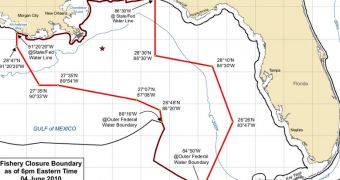Officials at the US National Oceanic and Atmospheric Administration (NOAA) announce that they have just allowed for the reopening of no less than 16,000 square miles of formerly-closed fishing zones in the Gulf of Mexico. The areas were locked out of public and commercial use because there was a real danger that fish and other marine animals captured at these locations may have been contaminated with oil leaking from the Deepwater Horizon accident site. Those worries proved to be unfounded for some particular regions, and so they are now opened again.
The largest reopened area lies just west of the Florida Keys and Dry Tortugas, and covers an impressive 13,653-square mile area. “It was initially closed on June 2 as a precaution because oil was projected to be within the area over the next 48 hours. However, the review of satellite imagery, radar and aerial data indicated that oil had not moved into the area. Additionally, the agency closed a 2,275-square mile area off the Florida panhandle federal-state waterline, extending the northern boundary just east of the western edge of Choctawhatchee Bay,” NOAA representatives write in a press release dated June 4.
At this point, more than 78,182 square miles of federally-controlled waters in the Gulf of Mexico are closed down for fishing. This is the rough equivalent of 32 percent of the entire territory the US federal government controls. The remaining 68 percent is still considered to be safe for fishing. “Federal and state governments have systems in place to test and monitor seafood safety, prohibit harvesting from affected areas and keep oiled products out of the marketplace. NOAA continues to work closely with the US Food and Drug Administration and the states to ensure seafood safety, by closing fishing areas where tainted seafood could potentially be caught, and assessing whether seafood is tainted or contaminated to levels that pose a risk to human health,” the statement further reads.
The Deepwater Horizon semi-submersible drilling rig, which operated only tens of miles south of the coasts of Louisiana, suffered a large explosion on April 20. Eleven crew members are assumed dead, and all rescue efforts aimed at finding them have long since been called off. On April 22, the rig sunk into the waters of the Gulf, in spite of the fact that emergency response ships were on-site, evacuating workers, and pouring water on the platform. With the collapse of the Horizon, the pipes that carried the oil from a depth of 5,000 feet (1,500 meters), broke.
The valves designed to stop the oil flow in such an instance malfunctioned, and between 12,000 and 19,000 barrels of crude have been spilling in the water daily ever since. Actual amount may be a lot larger than this, experts warn, which means that the damage may be considerably larger than initially estimated. Given the size of the slick, some hypothesize that the oil may have moved from the site in underwater plumes, which are extremely difficult to detect, even with sensitive Earth-observing satellites.

 14 DAY TRIAL //
14 DAY TRIAL //